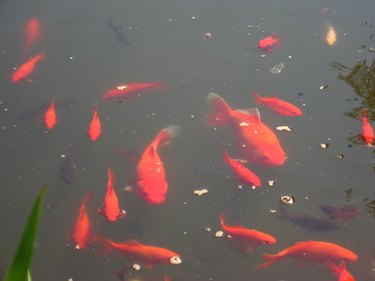Tip
Begin your pond cleaning early in the morning so that the new pond water has enough time in the warm afternoon sun to stabilize the water temperature. Maintaining a similar water temperature for your fish while transferring them into the holding tank and back into the pond is crucial to preventing shock.

Cleaning your pond is a big, dirty job, and it's especially laborious and tedious when you have fish in your pond. To clean your pond properly without killing your fish, you will need to remove the fish from the pond and have an appropriate environment for them to stay in while you're cleaning. But no matter how worried you are about killing your fish, a deep pond cleaning is essential to the health of your pond, as well as the fish and plants that live in it. You should clean your pond once every year, in the spring or fall.
Step 1
Place a large container, such as a children's swimming pool or large aquarium, in a shaded location near your pond. Make sure the container is large enough for all of your fish.
Video of the Day
Step 2
Fill the container two-thirds of the way with half pond water and half clean water. If you're using tap water, add one tablet of dechlorinator. Place a submersible pump or aeration unit into the fish-holding container.
Step 3
Remove your fish from the pond using a net and gently place them into the container. Remove your pond plants and place them in another container filled with the pond water.
Step 4
Take apart your pond filter and rinse the inside components and filter pads or other materials with a hose. Replace worn-out filter materials. Reassemble your pond filter.
Step 5
Drain your pond using a wet/dry shop vac, by rerouting the hose from your submersible pond pump to outside the pond, or by turning the valve on your bead filter to the "drain" position. Try to drain as much water from your pond as possible and then turn off the power to the pump or filter.
Step 6
Scrape away and remove any mud, silt and other debris on the walls of your pond. You can also spray the walls of the pond and the rocks in and around the pond with a hose using a pressure nozzle attachment or with a pressure washer. Suck up the mud with a wet/dry shop vac.
Step 7
Scrub away the algae from the walls of your pond using a sponge or scrub brush and clean water. Gently wipe away any algae growing on your pond plants, and then place them back into the pond.
Step 8
Empty the old pond water from the plant-holding container back into the pond. Fill the pond the rest of the way with clean water. Add a dechlorinating tablet to the pond water.
Step 9
Allow the new pond water to warm up so that it becomes about the same temperature as the water in the fish-holding tank. Then, place the fish back into the pond, dump the water from the fish-holding tank back into the pond, and turn your filters or pump back on.
Video of the Day